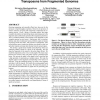8 search results - page 1 / 2 » Comparing Assemblies Using Fragments and Mate-Pairs |
WABI
2001
Springer
13 years 9 months ago
2001
Springer
Using current technology, large consecutive stretches of DNA (such as whole chromosomes) are usually assembled from short fragments obtained by shotgun sequencing, or from fragment...
CAINE
2008
13 years 6 months ago
2008
Assembly is an NP-Hard problem, which involves comparing fragments that have a time complexity of O(n2 ). This paper presents a parallel approach for sequence assembly. The parall...
BMCBI
2007
13 years 4 months ago
2007
Background: Yu et al. (BMC Bioinformatics 2007,8: 145+) have recently compared the performance of several methods for the detection of genomic amplification and deletion breakpoin...
BCB
2010
12 years 12 months ago
2010
Growing sequencing and assembly efforts have been met by the advances in high throughput machines. However, the presence of massive amounts of repeats and transposons complicates ...
BMCBI
2010
13 years 5 months ago
2010
Background: Finishing is the process of improving the quality and utility of draft genome sequences generated by shotgun sequencing and computational assembly. Finishing can invol...

